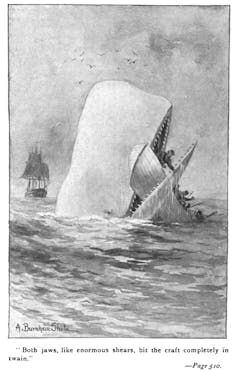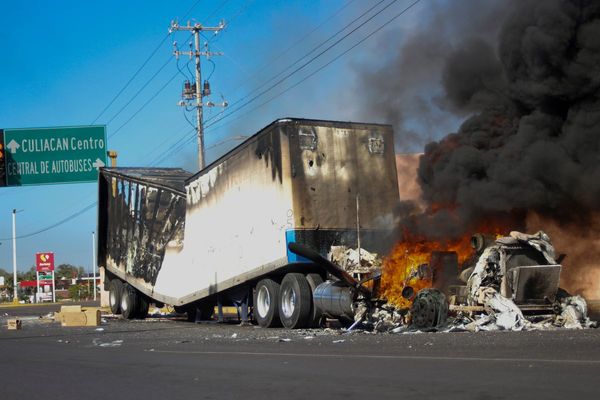
Orcas living off Europe's Iberian coast recently struck and sunk a yacht in the Strait of Gibraltar. Scientists suspect that this is the third vessel this subpopulation of killer whales has capsized since May 2020, when a female orca believed to be the originator of this behaviour suffered a traumatic encounter with a boat.
In most reported cases, orcas are biting, bending and breaking off the rudders of sailboats. So how did they learn to imitate this behaviour – and why? We asked Dr. Luke Rendell, who researches learning, behaviour and communication among marine mammals at the University of St Andrews.
Why do you think orcas appear to be attacking boats off the Iberian coast?
Any answer that I (or anyone else, really) give to this question is speculation – we just don't know enough about killer whale motivations to be certain. The puzzle for biologists is to understand how this behaviour developed.
Damaging boats in such a determined way is, however, not something I have ever heard orcas do before.
The lack of obvious fitness-enhancing rewards (like food, for example) means this is unlikely to have evolved because it enabled the whales to better survive in their environment. That is what we would call an adaptive trait: it confers a direct evolutionary benefit by helping the animal find food, mate, or successfully raise offspring.
But I can say what this behaviour looks like. There are multiple accounts of single and groups of orcas developing idiosyncratic and not obviously adaptive habits. These range from one group engaging in what seemed like a short-term fad of carrying dead salmon on their heads, to another vocally mimicking sea lions (there may be an adaptive outcome to convincing sea lions that you are a sea lion too, not a voracious predator, but there's no evidence of this occurring).
There are other kinds of behaviour that do appear to bring rewards – for example, captive orcas learning to regurgitate fish to use as bait for gulls, which they apparently prefer to eat over the fish. But the origin and spread of these boat attacks currently fits very well with the characterisation of a temporary fad, and it remains to be seen how long it persists.
If instead there is an adaptive explanation, my hunch is it has to do with curiosity sometimes leading to important innovations around food sources, which can then be shared.
How do you suspect this behaviour is being transmitted among killer whales in the region?
This behaviour probably started with individual orcas, but would appear to spread through social learning. We recently published a paper on a similar fad-like behaviour in bottlenose dolphins, where we identified the dolphin that promoted a tail-walking behaviour it had acquired during a temporary period of captivity.
This is pretty similar to the account of an academic journal on the recent yacht sinking, in that a specific individual was identified as the potential source. This orca was prompted to engage in the behaviour due to a past trauma – perhaps being struck by a boat rudder, according to the account.
The precise reason is very hard to know for sure, but we do know the behaviour has spread through her group. And it's difficult to explain that dynamic without involving some kind of social learning – the spread of information.
Is there evidence of killer whales behaving this way in the past?
I have experienced orcas swimming very close to our boat in the waters near St Vincent, in the eastern Caribbean, during a research survey. Our vessel, like those involved in these interactions, was about the size of a large whale (a humpback, for instance). Maybe they were investigating us, but it never escalated to any kind of physical interaction.

An illustration from an early edition of Herman Melville's Moby-Dick. Augustus Burnham Shute
My impression was that they were interested in the boat's propeller, and the currents it created – they came so close on one occasion that we had to take the engine out of gear to prevent an injury. So, approaching boats is not novel. Damaging them in such a determined way is, however, not something I have ever heard orcas do before.
It is, of course, known to happen in other species – notably sperm whales, giving rise to the story of Moby Dick: a combination of accounts of a white whale off the South American coast dubbed "Mocha Dick", and the account of the whaler Essex, sunk by a large sperm whale in equatorial waters.
The subpopulation of orcas responsible for these attacks is critically endangered. Do you think the group's conservation status is relevant in some way?
I don't think it's particularly relevant to the origin and spread of the behaviour, but it is highly relevant to how we should manage this population.
If these killer whales continue attacking boats, it will make protecting them harder. Not only does interacting with revolving propellers increase the risk of injury to these animals, it also threatens people – from the injuring of crews to the sinking of vessels – which will create political pressure for something to be done.
Of course, small vessel operators do not need to navigate the areas along the Atlantic coasts of Spain and Portugal where these interactions with orcas have been happening. Preventing them from doing so would solve the problem – but for many boat operators and owners, this is their shortest route, while heading offshore makes for riskier passages. A loss of tourism revenue if these vessels stop will add to pressure for a permanent solution.
If these killer whales continue attacking boats, it will make protecting them harder.
It is possible that some will call for these orcas to be controlled, up to and including having them killed if they continue to threaten human life and livelihoods. This poses significant ethical questions about our relationship with these animals.
Should we, as the species that ultimately holds the greatest power, vacate small, vulnerable vessels from the orcas' habitat as part of a shifting relationship to the sea, which we know is deteriorating as a result of our actions? Or should we confer on ourselves the right to navigate as we please and control any nonhuman animals that impede it, up to and including culling them?
Historically, the latter view would almost certainly have prevailed, and perhaps it will here. But it is a question which society, rather than scientists, must answer, and it will be telling which way the relevant authorities ultimately turn.
Reports indicate a 'traumatised' victim of a boat collision initiated the behaviour. Are notions of solidarity and self-defence among killer whales outlandish?
I regard this as plausible speculation. The authors of the recent paper cast it as one of a number of assumptions about how the behaviour might have developed, with generally increased pressure on their habitat and the idea of natural curiosity as other options (the latter is what I think is most likely).
Notions of collective self-defence in cetaceans (aquatic mammals including whales, dolphins and porpoises) are far from outlandish. We have accounts of sperm whales rising to each other's defence when orcas attack, for example. Solidarity is a more subjective issue, and we don't have access to the internal mental states of these animals to really understand whether this is going on.
I can, however, point to a different cetacean: humpback whales apparently aid other species, notably seals, that are under attack from orcas. The scientist who led the description of this behaviour, Robert Pitman, said he regards it as "inadvertent altruism" based on a simple rule of thumb: "When you hear a killer whale attack, go break it up."
These accounts raise interesting questions about the motivations behind orcas attacking boats that we cannot yet answer. It is not impossible that these orcas perceive their own common aggressor in us – but it is also entirely possible they have no such concept.
This article is republished from The Conversation under a Creative Commons license. Read the original article.







